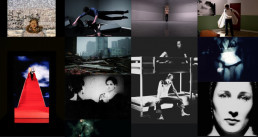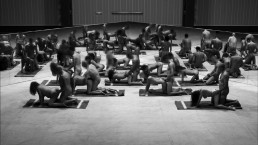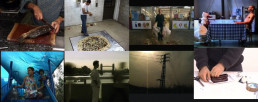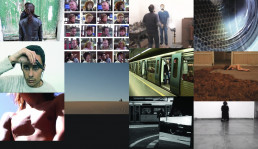2ª sessão – 1 Agosto, 0h30
Museu Coleção Berardo
Le Fresnoy, uma coletânea do corpo
Programa em parceria com Le Fresnoy – Studio national des Arts Contemporains, Tourcoing
Com a presença de Alain Fleisher e Dominique Païni
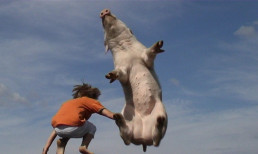
Veaceslau Druta, Sauts (2007), 1’30’’
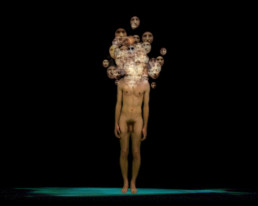
Laurent Perrot, Confusion (2004), 2’
Um homem nu e o caleidoscópio de rostos flutuantes chamam a nossa atenção nesta sequência de sonho de animação computadorizada. Sou eu apenas um indivíduo ou um ser cujas circunstâncias e paixões tornam cada momento diferente, uma sucessão de personagens, todas misturadas, como Proust no final de “A Busca do Tempo Perdido”? Sou eu algo mais do que a soma dos personagens que os outros projetam em mim? A identidade é a questão que nos atravessa ao longo da nossa existência, muitas vezes desfocada pelas máscaras que precisamos de usar para encaixar na sociedade; somos ao mesmo tempo o indivíduo e todos os indivíduos.
*Bernadette Delamarre em “L’existence: la mort, le bonheur”, Ellipses, Paris, 1996
Jean-Jacques Lebel, Les Avatars de Vénus (2007), instalação, 4’ (excerto)
Trata-se de uma média metragem de cerca de 35 minutos, preenchidos por mais de mil imagens tratadas segundo o processo denominado – morphing, de maneira que se fundem organicamente uma na outra, constituindo uma única Vénus elástica, infinita, em continua metamorfose, evoluindo ao som de músicas originais adaptadas aos ritmos da transformação das diferentes imagens. Organizada em 12 sequências temáticas, este filme demonstra a permanência dos arquétipos para lá das fronteiras culturais e temporais e lança, com humor um olhar espectral sobre a iconografia de todas as Vénus do mundo.

Nathalie Michel, Ci-Vit (1998), 7’32’’ (excertos)
Ci-Vit é um filme que nos mostra o encontro de um bailarino com um espaço. A dança aqui é principalmente improvisação; improvisação em reação direta ao som, tátil, meteorológica e por fim com os elementos visuais do espaço. O bailarino movimenta-se livremente no espaço: tendo em consideração uma certa duração temporal de cada vez, uma moldura, uma intensidade de reação e as possibilidades sonoras e “solares” de cada território.
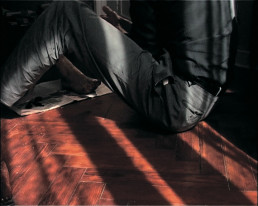
Yaël Perlman, Chute (2004), 3’
Uma mulher nua, em pé.
O seu corpo cai, os seus membros separam-se.
Desmorona-se. Um monte.
A imagem de um corpo desmembrado que cai sobre si mesmo.
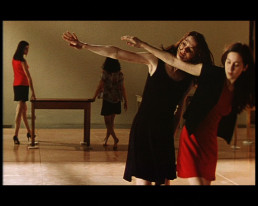
Thierry de Mey, 21 études à dancer (1999), (excertos: études 3, 4, 12, 17, 19 e 20)
Em terminologia musical o termo “estudo” designa formas de abordar um problema específico: estudo para “arpeggios”, para canhotos, etc. A questão é aqui é como fundir sequências de dança com elementos de ficção. Qual o tom correto, a proporção certa para contar/dançar uma história sem recorrer às técnicas dos musicais ou do ballet? Novas formas de contar uma história: esta é sem dúvida um desafio crítico para a dança de hoje. Vinte e uma microficções pelos bailarinos de Cie Michèle Anne De Mey onde o aspeto educacional da experimentação rapidamente dá lugar ao prazer da alegria poética: uma original mistura de insolência terna e pura elegância.
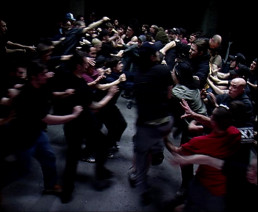
Fabien Giraud, The Straight Edge (2005), 13’, 6’ (excerto)
Uma multidão dança ao som de uma música que não se ouve, tocada por uma banda que não se vê. O que fica é o som dos corpos em movimento, a imagem de uma ordem em movimento.
The Straight Edge é uma experiência conduzida num concerto de hard-rock punk. O público e a sua intensidade forneceram a matéria. As expressões partilhadas de alegria, violência e tédio são os elementos da ficção cultural aqui em jogo. No seu interior formas são tentadas, moldadas, repetidas.
Abordo a comunidade como uma interação complexa na qual os indivíduos se inventam. Partilhando regras, posturas e ritmos, cada um se constrói a sim mesmo e cria um mundo. Este movimento de construção é o coração do meu trabalho. Acredito que é sempre flexível, modificável, que pode ser alterado e recriado. Acredito na ficção e na possibilidade da sua reinvenção.
Agradecimentos a Noémie Tranchant, Philippe Wagner, Blaise Basdevant, Guillaume Ségur, Emilie Godreuil, Anna Katharina Scheidegger.
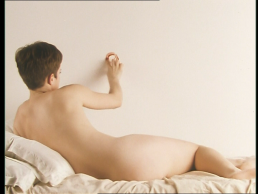
Christine Baudillon, Sexless (1998), 7’
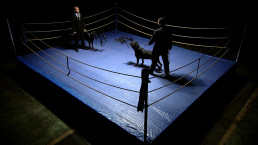
Mihai Grecu, Unlith (2007), 2’50’’
Homens e cães circulam num espaço de sonho. As suas ações, que se desenrolam em quatro salas diferentes, interligam-se. Aumenta a tensão e circula entre os espaços. É um diálogo abstrato que se alimenta de agressão e de ritos que se iniciam e terminam mutuamente. As relações estabelecidas entre as ações e os espaços transforma os corpos, desfia as leis da física e transfigura a matéria.
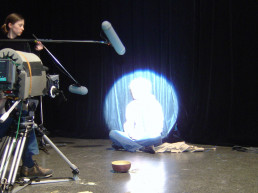
Hélène Iratchet, Ils semblait dire: “Let’s Dance!” (2006), 5’ (excerto)
Tendo por base a minha experiência anterior como bailarina e as minhas expectativas enquanto espectadora, decidi fazer um filme para o qual escrevi um guião e onde desempenho um dos papéis.
A descoberta de um novo meio sobre o qual sei ou pretendo saber nenhum dos códigos, dá-me um novo e vertiginoso espaço para investigação e experimentação. Neste espaço, agarro o que acredito serem as ferramentas necessárias para fazer um filme: um guião, comediantes, diálogos, música, locais exteriores de filmagem e cenários construídos de raiz. O meu objetivo é transcrever para imagens a narrativa, revisitar noções com que tive contacto em palco: entusiasmo e desilusão, amor, ídolos, o mistério da criação e até ficção científica…
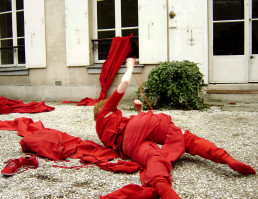
Florent + Trochel, Scenarii (2006), 14’41’’
Num enquadramento estático de uma filmagem contínua, estilhaços de atividade humana – cenários infinitos justapostos – progressivamente agregados no espaço de um jardim.
As personagens surgem inicialmente num estilo banal quase descartável, que nos deixa perceber algo de teatral, de coreográfico.
No fluxo destes eventos desconectados, fora do ecrã um fio de voz responde, alongada ao estilo de uma banda sonora: “(…) Poderia ser apenas sobre uma mulher que não sabe onde está ou para onde vai, que não sabe o que está a fazer neste jardim e não pode dizer porquê este jardim em particular, que talvez não saiba sequer – porque não reparou – que está neste jardim, e como tal não é capaz de considerar que a qualquer momento a sua presença ali é um problema, um problema de difícil solução (…)”.
Surgem ligação, por vezes explícitas, outras ténues, entre as trajetórias do som e da imagem, mas Scenarii procura manter estes componentes como dois caminhos separados. Através do que é mostrado e do que é ouvido, o que tenta emergir é precisamente o que se esconde entre os dois.
As zonas amovíveis e permeáveis entre a interioridade e a trajetória externa deste personagem ausente é o que Scenarii procura, não para apreender, mas para pelo menos tocar.
Agradecimentos a André S. Labarthe, François Rouan, Bérangère Jannelle, Anna Katharina Scheidegger e a toda a equipa do Fresnoy. Obrigado aos atores, à equipa de filmagem bem como a todos os que tornaram possível esta realização.
2nd session – August 1st, 12:30am
Museu Coleção Berardo
Le Fresnoy, uma coletânea do corpo
Program in partnership with Le Fresnoy – Studio national des Arts Contemporains, Tourcoing
With the presence of Alain Fleisher and Dominique Païni

Veaceslau Druta, Sauts (2007), 1’30’’

Laurent Perrot, Confusion (2004), 2’
One naked man and a kaleidoscope of floating faces capture your attention in this dreamy piece of computer animation. Am I a single man or a being whose circumstances and passions make each time different, a succession of character mixed all together, such as Proust at the end of “In search of lost time”?* Am I other-thing than the sum of characters that the others projected on me? The identity is a question which crosses us throughout our whole existence, and many times blurred by the masks that are necessary to wear to fit ourselves in society; We are at the same time a single man and all of the men.
*Bernadette Delamarre in L’existence: la mort, le bonheur, Ellipses, Paris, 1996
Jean-Jacques Lebel, Les Avatars de Vénus (2007), installation, 4’ (excerpt)
This digital film consists of over 800 images concerning “Venus-ness” – Venus iconology – from prehistory up until today, with all the forms the goddess has taken in different cultures and at different epochs. They are usually arranged in four sections, each projected onto a screen, with the 4 screens arranged like an open cube that viewers can enter and leave as they wish. In this context it appears in excerpts as a mono-channel screening.

Nathalie Michel, Ci-Vit (1998), 7’32’’ (excerpt)
Ci-Vit is a film which shows the encounter of a dancer with a space. The dance here is mostly improvisation; improvisation in direct reaction to the sound, tactile, meteorological and finally visual elements of the space. The dancer moves freely in the space: having to take into account a determined length of time each time, a frame, an intensity of reaction and the sound and “solar” possibilities of each territory.

Yaël Perlman, Chute (2004), 3’
A naked woman, standing up.
Her body falls, her limbs come apart.
She crumbles into piece. A heap.
The image of a dismembered body that falls into
itself.

Thierry de Mey, 21 études à dancer (1999), (excerpts: études 3, 4, 12, 17, 19 and 20)
In musical terminology, the term “study” designates pieces to approach a specific problem: study for arpeggios, for the left-handed, etc. The question here is how to merge dancing footage with elements of fiction. What is the right tone, the golden proportion to tell/dance the stories without resorting to techniques of a musical or a ballet? New ways of telling a story: this is, without a doubt, a critical challenge for dance today. Twenty-one micro fictions by Cie Michèle Anne De Mey dancers in which the educational aspect of experimentation soon gives way to the pleasure of joyful poetics: an original blend of tender insolence and strict elegance.

Fabien Giraud, The Straight Edge (2005), 13’, 6’ (excerpt)
A crowd dances to the sound of a music that is not heard played by a band that is not seen. What is left is the sound of the bodies in movement, the image of a moving order.
“The Straight Edge” is an experiment conducted in a concert of hardcore punk music. The crowd and its intensity provide the material. The shared expressions of joy, violence, and boredom are the elements of the cultural fiction at stake here. Within it, forms are tried, shifted, repeated.
I approach community as a complex interplay in which individuals invent themselves. Sharing rules, postures, rhythms, each one constructs itself and creates a world. This movement of construction is at the heart of my work. I believe that it is always flexible, modifiable, that it can be altered and recreated. I believe in the fiction and the possibility of its reinvention.
Thanks to: Noémie Tranchant, Philippe Wagner, Blaise Basdevant, Guillaume Ségur, Emilie Godreuil, Anna Katharina Scheidegger

Christine Baudillon, Sexless (1998), 7’

Mihai Grecu, Unlith (2007), 2’50’’
Men and dogs move round in a dreamlike space. Their actions, which take place in four different rooms, link in with each other. Tensions mount, circulate between the spaces. It is an abstract dialogue which feeds on the aggression and the semi ritual gestures that are set off and cancelled mutually. The relations which are created between actions and spaces metamorphose the bodies, defy physical laws and transfigure matter.

Hélène Iratchet, Ils semblait dire: “Let’s Dance!” (2006), 5’ (excerpt)
Based on my previous experience as a dancer and my expectations as a spectator, I have decided to make a film for which I have written a scenario and acted one of the parts.
The discovery of a new medium about which I know, or pretend to know, none of the codes, provides me with a new and vertiginous space for investigation and experimentation. In this space, I grasp what I believe to be the necessary tools to make a film: a scenario, comedians, dialogues, music, outside locations and sets built from scratch. My aim is to transcribe into images a narrative, to revisit notions that I had touched upon on stage: enthusiasm and disillusionment, love, idols, the mystery of creation, and even science fiction…

Florent + Trochel, Scenarii (2006), 14’41’’
In the stable frame of a continuous shot, scattered bits of human activities – infinitesimal scenarios juxtaposed together – progressively aggregate within the space of a garden. Characters first appear in a near-dismissible banal fashion, and yet something theatrical, choreographic is perceptible.
To the flow of these disconnected events, the thread of an off-screen voice responds, elongated like a continuous soundtrack: “(…) it could just as well be about a woman who does not know where she is, or where she is going, who does not know what she is doing in this garden, and cannot say why this garden in particular, and why at this moment in particular, who perhaps does not even know – because she does not notice – that she is in this garden, and could not as a result be able to consider that, at any point, her presence there is an issue, an issue with a truly difficult solution (…)”
Connections appear, sometimes explicit, sometimes tenuous, between the trajectories of the sound and the image, but Scenarii seeks to keep these components as two independent tracks. Through what is shown and what is audible, what tries to emerge is precisely what is hidden between the two.
The shifting and permeable zones between the interiority and the outward trajectory of this absent character are what Scenarii seeks, if not to seize, at least to touch upon.
